The Double Cluster
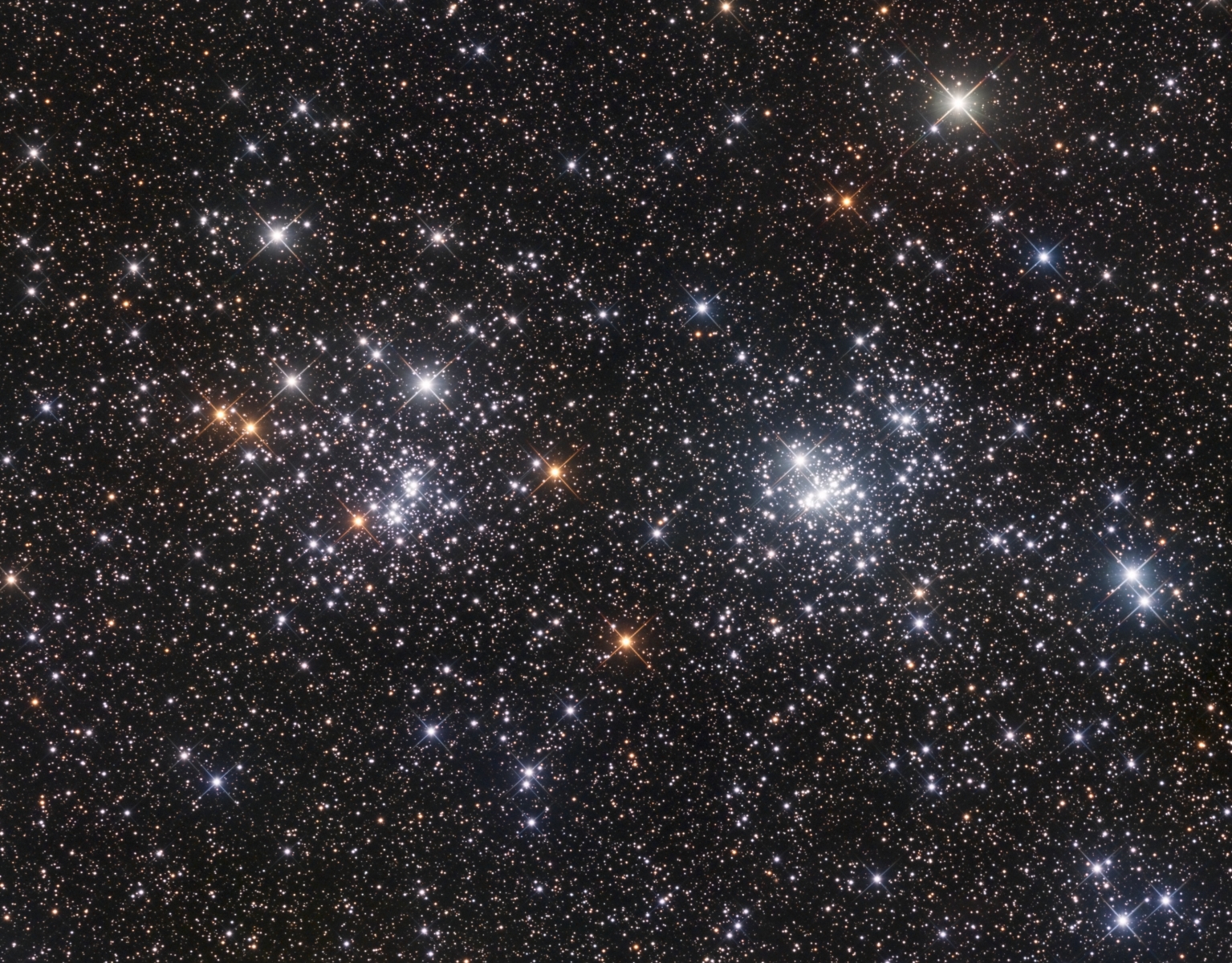 Click image for full size version
Click image for full size version
September 16, 2016, First Light with Moravian G3-16200 camera
The Double Cluster includes NGC869 (right) and NGC884, (known as h- and Chi-Pereus, respectively), each showing hundreds of stars. These clusters were bright enough to get star designations, and are both visible to the naked eye as foggy patches in a dark sky not far below the “left” side of the “W” of Cassiopeia in an autumn sky. In binoculars this pair looks like salt sprinkled in two little piles on a black tablecloth. In a small telescope the view is wonderful. Large telescopes reveal more stars, but tend to have too small a field to show the whole thing at once.
Both clusters are about 13 million years old (compared to 75-150 million years for the Pleiades). They lie about 7,500 light years away and a few hundred light years apart, and have a combined mass of about 6,500 times the mass of our Sun. However, the clusters have a halo totalling more than 20,000 solar masses. Each contains more than 300 blue giant stars. The clusters are moving towards us at a speed of about 40 km/s.
This is the first light image taken with a Moravian G3-16200 camera which I am demoing for O’Telescope, Moravian’s Canadian dealer. My first impressions are that this is a well built, solid camera that gave me no surprises. This image was taken during the nights of September 14 and 15, when the moon was nearly full! The original uncropped image contains a much larger field, but I cropped and rotated to better frame the clusters. The larger version shows good stars right to the corners. Note that this image was acquired under a nearly full moon and so-so conditions. I am not sure why a lot of imagers don’t bother to image when the moon is out…
Finally, I imaged this object in 2011 with different equipment and ten times less exposure time. I left the web post from 2015 available for comparison.
Tekkies
Moravian G3-16200 EC camera (on loan from O’Telescope), Optolong RGB filters, 10″ f/3.6 ASA astrograph, Paramount MX, QHY5 guide camera through Lumicon 500 mm f.l. achromat. Acquisition with the SkyX, Focusing with FocusMax. All pre-processing and processing in PixInsight. Acquired from my SkyShed in Guelph. Nearly full moon, no cloud, average transparency and average seeing.
28x10m R, 20x10m G and 21x10m B unbinned frames (total=11hr 30m).
RGB
Creation and cleanup: R, G and B masters were cropped and processed separately with DBE. R, G and B were combined to make an RGB image which was processed with ColorCalibration.
Linear Noise Reduction: MultiscaleLinearTransform was used to reduce noise in the background areas. Layer settings for threshold and strength: Layer 1: 3.0, 0.5 Layer 2: 2.0, 0.35 Layer 3: 1.0, 0.2 Layer 4: 0.5, 0.1
Stretching: HistogramTransformation was applied to make a pleasing yet bright image.
Synthetic Luminance:
Creation and cleanup of SynthL: The cleaned up R,G and B masters were combined using the ImageIntegration tool (average, additive with scaling, noise evaluation, iterative K-sigma / biweight midvariance, no pixel rejection).
Linear Noise Reduction: MultiscaleLinearTransform was applied to reduce the noise. Layer settings for threshold and strength: Layer 1: 3.0, 0.5 Layer 2: 2.0, 0.35 Layer 3: 1.0, 0.2 Layer 4: 0.5, 0.1
Stretching: HistogramTransformation was applied to make a pleasing yet bright image. TGVDenoise was applied and the image was re-stretched to reset the black point.
Combining SynthL with RGB:
The luminance channel of the RGB image was extracted, processed and then added back into the RGB image as follows:
1. Extract luminance from the RGB image.
2. Apply LinearFit using SynthL as the reference.
3. Use ChannelCombination in Lab mode to replace the RGB’s luminance with the fitted luminance from step 2.
4. LRGBCombine was then used to make a SynthLRGB image.
Final Processing of SynthLRGB:
Background and star brightness, contrast and saturation were adjusted in several iterations using Curves with masks as required.
Image scale is 1.36 arcsec per pixel for this camera / telescope combination.

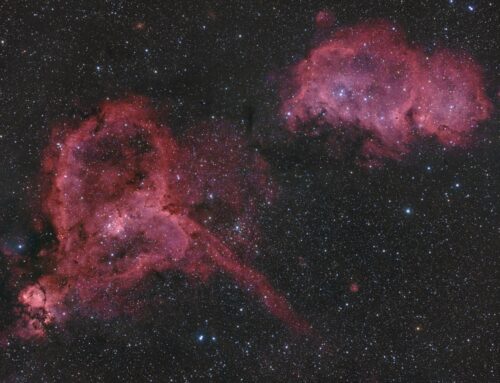
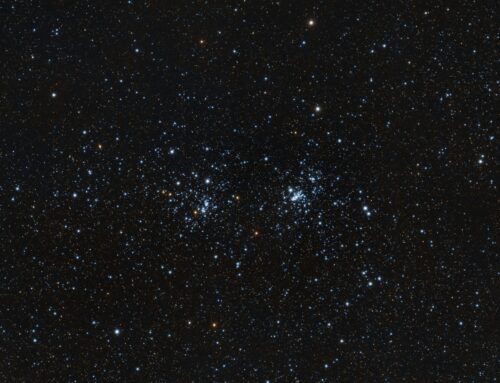
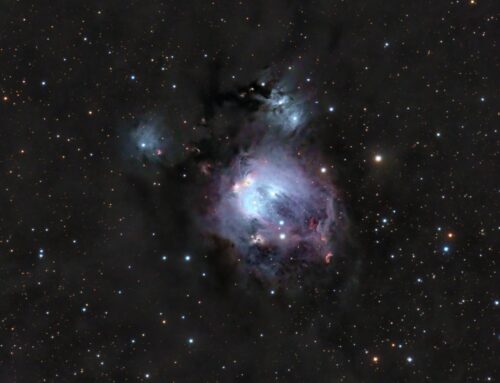
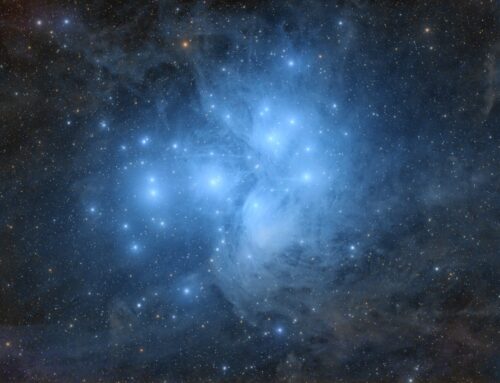
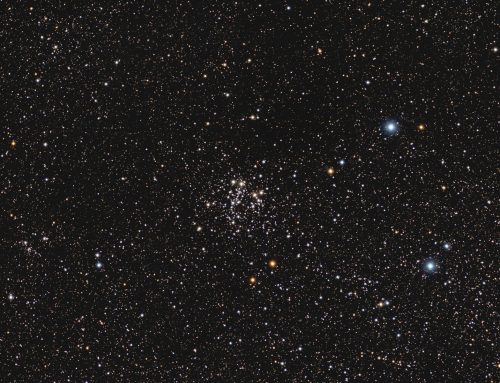
I nteresting. My only image so far with the G3-16200 also showed very clean stars right to the corners at f/3.6.
This looks great for full moon!